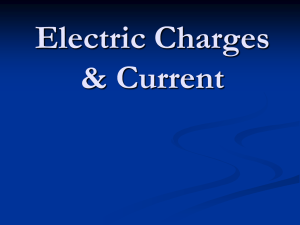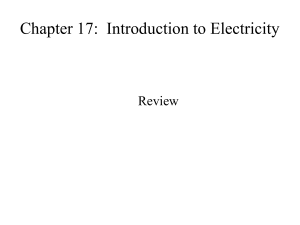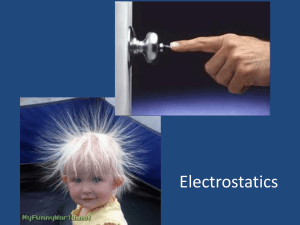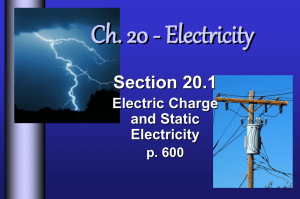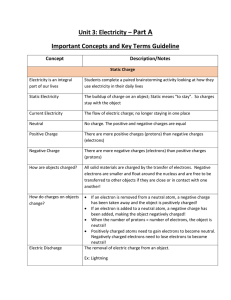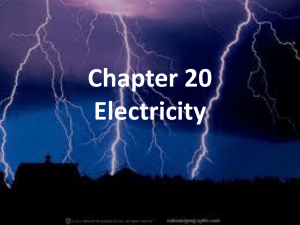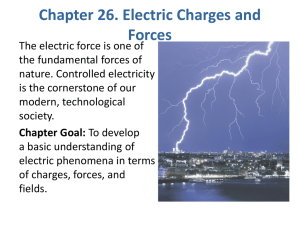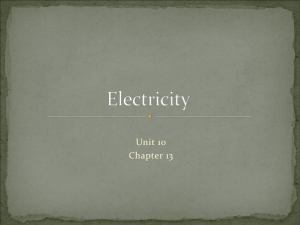Electricity Notes Ch. 6
advertisement
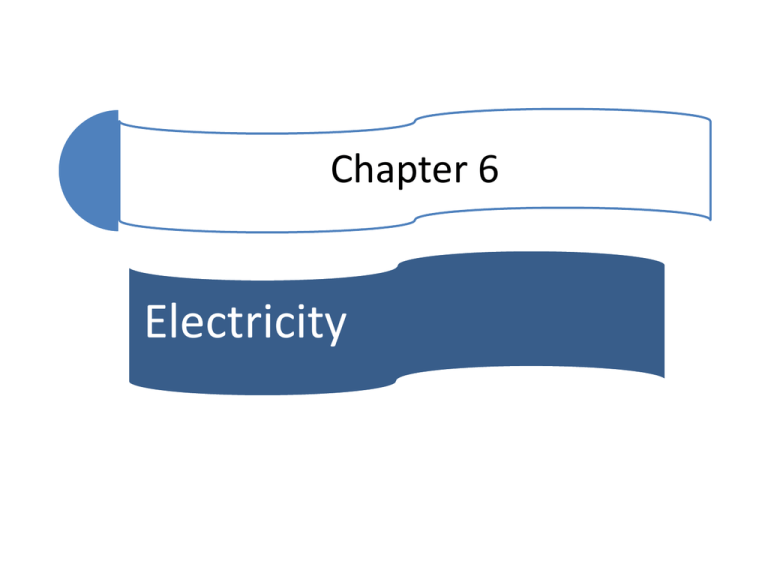
Chapter 6 Electricity Section 1: Electric Charge and Static Electricity • A force is a push or pull exerted on an object. • Energy is the ability to do work or cause change. • Potential energy is the stored energy that results from the position or shape of an object. Key Concepts • 1. Charges that are the same repel each other. Charges that are different attract each other. • 2. There are 4 methods by which charges can redistribute themselves to build up static electricity: by friction, by conduction, by induction, and by polarization. How do charges interact? Atoms contain charged particles called electrons and protons. The charge on a proton is positive (+). The charge on an electron is negative (-). If 2 electrons or 2 protons come closer together, they push each other apart. If a proton and an electron come close together, they attract one another because they have opposite electric charges. * The interaction between electric charges is called electricity. * The force between charged objects is called electric force. * An electric field is a region around a charged object where the object’s electric force is exerted on other charged objects. * Electric fields and forces get weaker the farther away they are from the charge. How does charge build up? •The buildup of charges on an object is called static electricity. In static electricity, charges build up on an object, but they do not flow continuously. •Law of Conservation of Charge: Charges are neither created nor destroyed. An object cannot become charged by destroying or creating its own electrons. If one object loses electrons, another object must pick them up. 4 ways to build up static electricity: 1. By friction- the transfer of electrons from one uncharged object to another by rubbing the objects together. 2. By conduction- the transfer of electrons from one object to another by direct contact. 3. By induction - electrons react to the electric field of a charged object without touching the object itself. 4. By polarization – electrons move within their own atoms because of an external electric field. Static discharge results in the loss of static electricity as electric charges transfer from one object to another. A spark is often produced. Lightning bolts are examples of static discharge. Section 2: Electric Current 1. When electric charges are made to flow through a material, they produce an electric current. 2. The unit for the rate of electric current is the ampere (amp) or A. The number of amps describes the amount of charge flowing past a given point per second. 3. A complete, unbroken path that charges can flow through is an electric circuit. Conductors and Insulators 1. A conductor allows electrons to flow easily through it (are loosely bound);metals are good conductors 2. Insulators do not allow electrons to flow easily; electrons cannot move freely. 3. Current flow is affected by the energy of the charges and the properties of the objects that the charges flow through. Circuits convert electric potential energy into light and heat. Voltage (V) is the difference in electric potential energy per charge between 2 points in a circuit. Resistance measures how difficult it is for charges to flow through the object. The greater the resistance, the less current there is for a given voltage. The ohm (Ω) is the unit of measure for resistance. 4 factors determining resistance: diameter, length, material, and temperature. Current will always take the path of least resistance. Section 3: Electric Circuits Ohm’s Law: Resistance = Voltage Current Ohms (Ω) = volts (V) ÷ amps (A ) One ohm = one volt per amp Voltage = Current · Resistance All electric circuits have: 1) Devices that run on electrical energy 2) Sources of electrical energy 3) Conducting wires Energy is always conserved in a circuit; it will be transformed into heat, light, sound, or mechanical energy. Circuits usually have a switch to control the current. A series circuit has only one path for the current to take. Disadvantages of series circuit: 1. If one light goes out, all the others do also. 2. Light bulbs become dimmer as more are added to the series. Parallel Circuit: There are several paths for the current to take. Advantage: if one bulb burns out, the others will stay lit. Overall resistance decreases, do bulbs do not grow dim as more are added to the circuit. Section 4: Electric Power and Safety Power: the rate at which energy is transformed from one form to another; the unit of power is the WATT Power = Voltage ∙ Current Units: watts (W) = volts (V) ∙ amperes(A) You can rearrange the equation do it reads: Current = Power Voltage ***See page 183 for problems*** Energy = Power ∙ Time * Electric power is measured in kilowatts (kW); time measured in hours, so electrical energy often is measured in kilowatt-hours (kWh). Shocks can be prevented by the third prong on plugs (connects to house’s ground wire), circuit breakers, and fuses. These things either redirect current or break circuits.

